从南美洲三国大选看拉美政治生态变化
- 格式:docx
- 大小:11.69 KB
- 文档页数:2
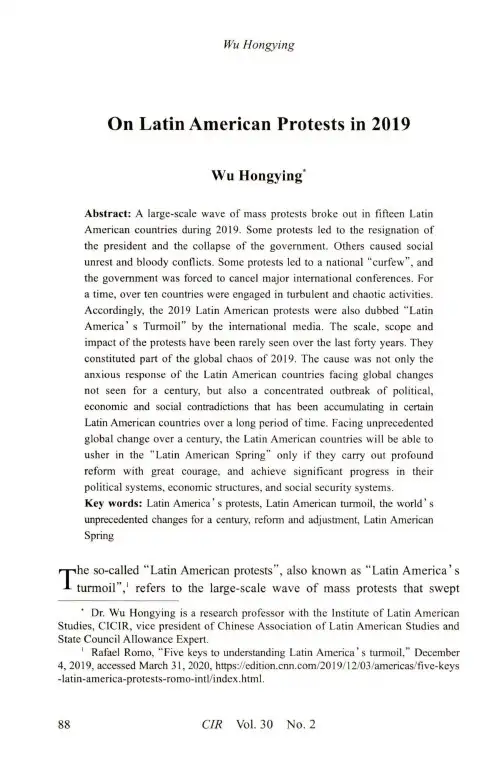
W u HongyingOn Latin American Protests in 2019Wu Hongying*Abstract: A large-scale wave o f mass protests broke out in fifteen LatinAm erican countries during 2019. Some protests led to the resignation o fthe president and the collapse o f the governm ent. Others caused socialunrest and bloody conflicts. Some protests led to a national “curfew”,andthe governm ent was forced to cancel m ajor international conferences. Fora time, over ten countries were engaged in turbulent and chaotic activities.Accordingly, the 2019 Latin American protests w ere also dubbed uLatinA m erica’s T urm oil” by the international media. The scale, scope andim pact o f the protests have been rarely seen over the last forty years. Theyconstituted part o f the global chaos o f 2019. The cause was not only theanxious response o f the Latin American countries facing global changesnot seen for a century, but also a concentrated outbreak o f political,economic and social contradictions that has been accumulating in certainLatin American countries over a long period o f time. Facing unprecedentedglobal change over a century, the Latin Am erican countries will be able tousher in the “Latin American Spring” only if they carry out profoundreform with great courage, and achieve significant progress in theirpolitical system s, economic structures, and social security systems.Key words: Latin Am erica’s protests,Latin American turmoil, the w orld’sunprecedented changes for a century, reform and adjustment, Latin AmericanSpringT he so-called “Latin American protests”,also known as “Latin America’s turmoil”,*1refers to the large-scale wave of mass protests that swept• Dr. Wu H ongying is a research professor with the Institute o f Latin American Studies, CICIR, vice president o f Chinese A ssociation o f Latin American Studies and State Council Allowance Expert.1Rafael Romo, “Five keys to understanding Latin A m erica’s turmoil,” December 4, 2019, accessed March 31, 2020, https:///2019/12/03/americas/five-keys-latin-am erica-protests-rom o-intl/index.htm l.88CIR Vol. 30 No. 2On Latin American Protests in 2019across 15 countries in Latin America during 2019, as well as the severe social unrest and sharp political turbulence that ensued. This constituted part of the 2019 global chaos. The cause was not only the anxious response of the Latin American countries facing global changes not seen for a century, but also a concentrated outbreak of political, economic and social contradictions that has been accumulating in certain Latin American countries over a long period of time. To some extent, it was also a concentrated reflection of the insufficient governance systems and capabilities of the Latin American countries. Facing unprecedented global change over a century, what next for the Latin American countries? This has become the “challenge of a century” for the Latin American countries in the 21 st century.An Unprecedented Wave of Mass Protests“2019 has been marked by political turmoil and popular outcry throughout Latin America.”i A large-scale wave of mass protests broke out in 15 Latin American countries during 2019. For a while, Latin America, known as the “Forgotten Continent”,12let the world break its glasses and ask, “W hat’s happening in Latin America?”3In sum, “Latin America’s turm oir presents with the following characteristics:Firstly, the wave of protests ran throughout the year 2019. In January, Venezuelan opposition leader Juan Guaido, with the support of the United States,“declared himself the interim president.” He fought fiercely with the elected President Nicolas Maduro, triggering sharp domestic political turmoil. In February, the Haitians protested against the corruption of officials on a large scale, demanding that President Moiz step down. In March, mass protests broke out in Nicaragua against pension reforms, and demanded that President Daniel Ortega, and his wife and Vice President1James B osw orth,“2019 has been a difficult year in Latin Am erica — 2020 may only get worse/* November 26, 2019, accessed March 31, 2020, https://www.businessinsider .com/political-instability-protests-in-latin-am erica-m ay-intensify-in-2020-2019-11.2Tom Phillips, <4An explosion o f protest, a howl o f rage-but not a Latin American spring,M October 24, 2019, accessed March 31, 2020, https:///world /2019/oct/24/latin-american-spring-protests-chile-ecuador-bolivia-haiti.3Rafael Romo, “Five keys to understanding Latin America ’ s turmoil.”CIR M arch/April 202089W u HongyingRosario Murillo step down. In April, a number of protests broke out in Paraguay, calling for the government to fight corruption. In May, demonstrations erupted in Honduras against the government' s plans to privatize health and education. In June, a national strike took place in Brazil, protesting government pension reforms. In July, the Venezuelan opposition set off another round of protests. In August, large-scale demonstrations broke out in M exico1s capital Mexico City, protesting against crimes related to discrimination against women. In August, protests against political corruption erupted in Honduras. In September, Peruvian President Martin Vizcarra announced the dissolution of the Congress, while the opposition-controlled parliament announced the suspension of the presidency. The “conflict between the legislative and the executive bodies” reached levels unprecedented in Peru,s history. In September, a national strike in Argentina burst out against a government budget cut. In early October, mass protests in Ecuador broke out against the cancellation of fuel subsidies. This escalated into serious social unrest, and the government was forced to “move the capital” to another city. In mid-October, large-scale protests were triggered by rising subway prices in Chile, and quickly escalated into bloody violent clashes. President Miguel Juan Sebastian Pifiera Echenique was forced to abandon hosting the APEC Informal Leadership Meeting and the UN Climate Change Conference. In late October, the Bolivian opposition accused President Morales of seeking re-election in order to cheat in the general election, and launched large-scale protests. Later these protests evolved into serious social unrest. At last, with the militaryJ s interference, President Evo Moraleswas forced to resign and went into exile in Mexico and Argentina. In late November, large-scale demonstrations broke out in Colombia in protest against the government' s privatization of state-owned enterprises and plans for pension reduction. These protests quickly escalated into violent clashes. In October, large-scale protests broke out simultaneously in eight countries (Haiti, Honduras, Argentina, Peru, Ecuador, Chile, Bolivia, Colombia), and this led to a resonance effect that propelled the “Latin American Turmoil” to a climax. A headline in Mexico *s El Universal newspaper in October declared Latin America90CIR Vol. 30 N o. 2On Latin American Protests in 2019and the Caribbean “red hot”.1Secondly, the scope of the protests was wide. “Historically,Latin America has seen two such similar periods of unified protests: during severe austerity in the 1980s and again during economic and political crises from 1998 to 2002.” But this round of wave of protests was more universal and more widespread. Fifteen countries out of Latin America’s 33 experienced large-scale waves of mass protests in 2019, accounting for nearly one-half of the Latin American countries and over 85 percent of Latin America' s area and population. At the same time, the wave of protests erupted not only in Brazil, Mexico, Argentina, and Colombia, the four largest Latin American economies, but also in some small countries such as Paraguay and Honduras; and not only in the OECD countries suchas Chile and Mexico, but also in Haiti, the w orld1s least developed country. Besides this, mass protests erupted not only in the right-wing ruled countries such as Brazil, Chile, and Colombia, but also in left-wing ruled countries such as Mexico, Venezuela, and Bolivia. In sum, this round of large-scale protests swept throughout the Latin American region, from South America to Central America, the Caribbean and Mexico in North America.Thirdly, young people comprised the main force in the protests. In the past, protesters represented a cross-section of social groups, with different interests. However, this wave of protests was characterized by the involvement of younger initiators and participants. Chile’s protests were first initiated by young people, and later received a wide response from people of all walksof life. They evolved into mass protests that involved over 1.2 million people. The Colombian protests were started by young students. These protests later escalated into a nationwide strike. The organizers of the El Salvador protest were also young college students, who pointed directly at fraud in the election of university presidents. It is clear that groups ranging from 18 to 35 years old, who are thoughtful, dare to act, and make good use of mobile phones, are not only the main force of this wave of protests,1Tom Phillips, 44 An explosion o f protest, a howl o f rage-but not a Latin American spring. ”CIR M arch/A pril 202091W u Hongyingbut that they are important organizers and leaders. As Latin American media put it: u Young students have demonstrated the role of leaders in the history of the country, and recently reshaped the meaning of the struggle, strengthened their representation in society and served as the starting point for the struggle for reform. Through social struggle, they awakened the people, fought for the constitutional order, and ushered in the ‘ Latin American Spring,•”丨Fourthly, social media acts as an “invisible organizer”. In the past, Latin American protests were mobilized principally by political parties, unions, or societies through “face to face” means. However, this wave of protests was organized chiefly through “invisible,inaudible, and intangible” social media. Regardless of the protests in Chile, Colombia, Peru, Mexico and other countries, almost all participants used social media such as Twitter, Instagram, Facebook12 on their mobile phones to contact, exchange, and communicate. Obviously, in an era where everyone has a mobile phone and social media has become the most convenient tool of communication, “social media and mobile technology have made it easy to organize effective protests, allowing young people to overcome government censorship and control.’’3The “bow-headed youth” and “headless groups” have become the most distinctive characteristics of this wave of protests. New social media has played the essential role of “invisible organizer” and “silent leader”. Latin American media commented that: “Unlike the second half of the 20th century, Latin Americans used modem scientific and technological achievements to organize and mobilize protests.” In Chile, students are using social networks to mobilize and organize demonstrations. As social media played a special role in this wave of protests, “Latin1O m ar Antonio Diaz Botiva, uColom bia y la prim avera latinoam ericana [Colom bia and the Latin American Spring],M O ctober 21, 2019, accessed March 31, 2020, https://s2orillas.co/colom bia-y-la-prim avera-latinoam ericana/.2Jorge Ramos, “Latin Americans are fUrious,” accessed March 31,2020, November 13, 2019, https://jorgeram /en/latin-am ericans-are-flirious/.3Ibid.92CIR Vol. 30 No. 2On Latin American Protests in 2019America’s turmoil” of 2019 is also referred to as the “high-tech protests.”1 Fifthly, violent tendencies are an obvious feature of this wave of protests. Latin Americans have a gentle nature and a respect for peace. However, the violent color of the 2019 protests was marked. Almost all protests began with peaceful demonstrations but ended with violent clashes. Some illegal activities also occurred, such as burning cars, burning subways, burning banks, burning public facilities, and so on. These protests “have the key signature of arson”,causing not only arson crime, but also escalating into bloody violence. The first incidence of violence was reported in Haiti on February 11, with four people getting killed on the first day of the anti-government riots. In Ecuador, ten people were killed and over 1,000 injured in the protests.12Protests in Bolivia left at least five people dead and dozens more injured.3At least three people were killed in the Colombian protests.4In Chile, there were 2,808 injuries during demonstrations, 1,737 of which were caused by firearms.5On the one hand the violent color of the protests reflects the extreme anger of the Latin American people with regard to the status quo. On the other hand, it also reflects the inadequate capacity of the Latin American governments to cope with serious crises. Although the protests in Latin America have largely been quashed, the root cause of the problems still exists, and it is possible that another wave of protests will break out in the future.Finally, “Latin America’s turmoil” constituted part of the global 1Monica Clua Losada and David J. Bailey, “The fUture o f protest is high tech -justlook at the Catalan independence m ovement/’November 5, 2019, accessed March 31,2020,https:///the-fUture-of-protest-is-high-tech-just-look-at-the-catalan-independence -movement-125776.2Jorge Ram os, <4Latin Am ericans are furious.M3“Bolivia protests: five killed in rally calling for exiled M orales’return,”N ovem ber 16, 2019, accessed M arch 31, 2020, https://w w /w orld /2019/nov/l 6/bolivia-protests-five-killed-in-rally-calling-for-exiled-m oraless-retum.4Manuel Rueda, 44Colombians join Latin Am erica' s protests,,?November 25, 2019,accessed March 31, 2020, https://news/world/2019/ll/25/ap-explains -colom bia-joins-latin-am ericas-wave-of-protests/.5Patricia Luna and Eva Vergara, 44 Chileans who lost eyes in protests demonstrate incapital,?,November 28, 2019, accessed March 31, 2020, https:///news/w orld/2019/11 /29/chileans-w ho-lost-eyes-in-protests-dem onstrate-in-capital/.CIR M arch/A pril 202093W u Hongyingchaos of 2019. Large-scale protests also erupted in Albania, Sudan, South Africa, Egypt, Algeria, Iran, Lebanon, Iraq, South Korea, India, Pakistan, Nepal, Indonesia, Kazakhstan and China?s Hong Kong, Spain, Germany, Switzerland, Romania, Serbia, Malta and Russia, etc. There were also the French “yellow vests movement”,the British “Brexit” campaign, the United States' anti-Trump protests, etc. The scope and scale of global protests in 2019 has been rarely seen for 50 years, making 2019 the most important year for global protests since 1968. Although these protests have no direct cause-effect relationship, they mutually transmit, imitate, and support one another, forming a global resonance effect and a butterfly effect. For example, protesters in Chile and Ecuador who “arsoned” and burned subways were clearly affected by the French “yellow vests movement” and the Hong Kong protests to a large degree. The British Magazine, the Economist,stated that 44Latin American protests form part of the wave of global protests in 2019.”Why Did the Latin American Protests Happen?Why did such large-scale protests break out in Latin America in 2019? This almost became a “question of the world”. After care f ill study, it can be found that the causes of “Latin America’s turmoil” are complex, with direct, indirect reasons, with historical and practical triggers, as well as domestic and external factors. Different countries also had their own different reasons. In general, the protests were characterized by the following different reasons.Firstly, some “seemingly small factors”1triggered the big protests. In Chile, large-scale protests broke out because of the increase of 30 pesos in the price of a subway ticket. This uled to the worst street violence in decades”,12and pushed the wave of Latin American protests to a high point1Adam Taylor, “Global protests share themes o f economic anger and political hopelessness/' October 26, 2019, accessed March 31, 2020,https://www. /world/2019/10/25/global-wave-protests-share-themes-economic-anger-political-hopelessness/.2Fareed Zakaria,“Why are there so m any protests across the globe right now?,” October 25, 2019, accessed March 31, 2020, https:///opinions /global-opinions/why-are-there-so-many-protests-across-the-globe-right-now/2019/10/24/ 5ced 176c-f69b-11 e9-ad8b-85e2aa00b5ce_story.htm l.94CIR Vol. 30 No. 2On Latin American Protests in 2019throughout the year. In Ecuador, the big demonstrations were triggered by the elimination of fuel subsidies. In Nicaragua and Colombia, many protestors opposed the governm ent's pensions reductions. In Honduras, the demonstrators reacted against reforms in medical care and education. In Argentina, some people took to the streets because of the planned budget cuts. Meanwhile, protests in Haiti, Bolivia, Peru, Colombia, and El Salvador were triggered by corruption scandals in the political parties and corruption charges against political figures. These “trigger points were considered the final straw in a build-up of small actions of perceived mismanagement and repression.”Secondly, the ongoing economic recession is a direct cause of the protests. Due to domestic and international factors, Latin America' s economy has continued to decline over the last six years. Latin A m erica's GDP grewby just 0.1 percent in 2019, which was lower than the 1.2 percent growth in 2017 and 1.0 percent growth in 2018. It was the slowest growth rate in three years, and growth in 2020 is not looking optimistic. Accordingly, 2014-2020 is set to become 4ia period of the lowest economic growth in Latin America for the past 40 years.”1Latin American economic growth in 2019 neither reached the average for developing countries (3.9 percent) nor the global average (3 percent); it did not reach the average level of developed countries (1.7 percent), and was far lower than the growth rateof Asian countries (5.9 percent), the region with the slowest global economic growth for six consecutive years. In 2019, twenty-three of Latin Am erica1 s33 countries did not grow as fast as they did in 2018, and 14 countries had growth rates of one percent or less. In particular, Venezuela, Nicaragua, Argentina, and Haiti had the slowest growth rates in the region: - 25.5 percent, -5.3 percent, -3.0 percent, and -0.7 percent respectively. At the same time, Latin America' s per capita GDP fell by 4.0 percent between 2014 and 2019. Unemployment rose from 8.0 percent in 2018 to 8.2 percent in 2019, and the unemployed population rose to 25.2 million, a1ECLAC, Preliminary O verview o f the Econom ies o f Latin A m erica and the Caribbean 2019,(U nited Nations publication, 2019), 11.CIR M arch/A pril 202095W u Hongyingrecord high.1 As a result of the economic downturn, the fiscal revenues of almost all governments decreased, and many countries were forced to reduce their public service subsidies and welfare benefits. This led to a decline in people’s living standards. The general population was extremely dissatisfied with the government’s austerity policies. In particular, the emerging middle class, who are at risk of “returning to poverty”,and the youth, who face the “triple pressures” of higher education, employment and life, were the most dissatisfied with the status quo, and they have become the initiators and main driving forces behind the protests. One Latin American scholar pointed out that ua fundamental factor of protest is the economic slowdown and stagnation suffered by most of the economies of the region as of 2014, with the end of the boom in raw materials.”12Thirdly, serious social injustice is another main cause of the protests. From the colonial era to today, Latin American economy and politics have basically followed the trajectory of “rich economy” and “elite politics”,that is, “from colonial times through today, Latin American economies have been set up for the benefit of the few.”3Although most Latin American countries won national independence in the 1830s, and the politics and economy of each country underwent nearly two hundred years of development, ordinary people didn’t really enjoy the benefits brought about by economic growth, except for political voting rights. In the first decade of the 21st century, with the rise of the “Golden Decade” of commodity prices, the left-wing Latin American governments generally adopted some social subsidy policies and poverty reduction measures. Brazil, for example, introduced the “Zero Hunger Program”,and the “Family Subsidies Plan”,which significantly reduced the number of people living in poverty. As a result, “while achieving strong economic1ECLAC, Preliminary O verview o f the E conom ies o f Latin Am erica and the Caribbean 2019, \ \9-\2\.2Gerardo Lissardy, uPor que la idea de que A m erica Latina gira hacia la derecha o izquierda perdio sentido en 2019 [Why the idea that Latin America turns to the right or left became meaningless in 2019]/' accessed March 31, 2020, https:///mundo /noticias-am erica-latina-50818892.3Jorge Ramos, “Latin Americans are furious.”96CIR Vol. 30 N o. 2On Latin American Protests in 2019growth, social injustice also declined.,M However, since 2014, as the economy has continued to decline, government revenue cuts and social subsidies have also been reduced. Public services have had to reduce accordingly, and this has led to a decline in the standard of living of ordinary people, a widening gap between rich and poor, and an aggravation of social injustice. uLatin America is still the most unequal region in the world; a huge gap continues to separate the wealthy and the poor.”123According to statistics, uLatin American countries occupy eight of the top ten spots in the list of most economically unequal.” Chile is the country with the highest economic freedoms, the highest per capita income, the lowest poverty rate, and the highest per capita social expenditure in Latin America. It stands to reason that large-scale protests should not be a feature of life here. But a closer look reveals that since Chile1 s education, healthcare, and transportation industries are heavily privatized, ordinary people enjoy less public welfare. As a result, 10 percent of wealthy people occupy an irrational wealth distribution of 37 percent of the national GDP. College students face the tremendous pressure of having to repay their education loans 20 years after graduation. Ordinary people deal with the daily reality of high prices. As a Chilean student in C hile’s capital Santiago said: “the pie is big enough for everybody, but those in power do not want to share with the middle and lower classes.,,3Indeed, social disparity is not only a deeply entrenched problem in Chile, but also in the region as a whole. This problem is tends not to be obvious during economic upswings, but it is particularly prominent and very sensitive during any rapid economic downturn. The wave of protests in Latin America in 2019 demonstrates once again that u Income inequality seems to have added an economic insecurity that helped lead to anger and protests”4. In particular, “the pressured middle class is extremely angry about corruption and inequality^, so they took to the streets1Julian M essina and Joana Silva, Wage Inequality in Latin Am erica.(World Bank, 2018), 1.2Jorge Ram os, “Latin Americans are ftirious.”3Rafael Romo, “Five keys to understanding Latin A m erica’s turm oil.”4Adam Taylor, <4A global wave o f protests share them es o f economic anger and political hopelessness/1 October 26,2019, accessed March 31,2020Jittps://www.washingtonpost .comAvaid/2019/10/25/global-wave-protests-share-themes-economic-anger-political-hopelessness/.CIR M arch/A pril 202097W u Hongyingto issue their “voice of anger”.1Fourthly, insufficient governance systems and incompetent governance capacity are also important reasons. After independence, most countries in Latin America generally followed the Western democratic political system. They formulated democratic constitutions, implemented the separation of powers, encouraged party politics, and promoted universal suffrage. In the 1980s, after the democratic movement erupted once again in Latin American countries, the region became a “democratic continent.” However, the large-scale protests that broke out in Latin America in 2019 fully exposed the lack of or immaturity of national governance systems and capabilities in the region. From the perspective of the legal system, the constitutional system of the Latin American countries is pretty complete, and the legal system is quite mature, but most of this is in paper and form. For example, most countries have formulated very strict laws, regulations and policies to guard against the corruption about which people are so angry. But “there are many examples of codes of conduct or internal policies that become dead letters or decorate a shelf.”12From the perspective of the political system, the Latin American countries have generally adopted the political system of “separation of three powers”. This was originally designed to achieve decentralization and seek a balance of power. In fact, however, it is a common phenomenon that the legislative, executive, and judicial branches often disagree with one another and are engaged in long-term combat. During this wave of protests, Venezuela' s u dispute between the executive and legislative branchesled to the appearance of “two presidents” and “two parliamentarians”.Peru’s “dispute between the executive and legislative branches” led to “a government with no president for a while”. As such, “Latin America’s citizens are angry at their political systems due to corruption and a lack of results on citizen1Ibid.2Yoab Bitran, “乙Podemos hablar de una ‘Prim avera Latinoam ericana’en Anticorrupci6n? [Can we speak of a “Latin American Spring” in Anticorruption?],” March 8, 2018, accessed March 31, 2020, https://es.weforum.oi^/agenda/2018/03/podemos-hablar-de -una-prim avera-latinoam ericana-en-anticorrupcion/.98CIR Vol. 30 No. 2On Latin American Protests in 2019security and economic promises.”1From the perspective of party politics,the Latin Am erican countries generally im plem ent a tw o-party or multi-party system, but a result of this is that almost all political parties act out of one-party self-interest, ignore national interests and blindly compete for power. Ultimately this leads to the frequent occurrence o f party disputes. Most ruling parties lack the ability to prevent and resolve economic and social crises. From the perspective of government policies, the Latin American countries generally adopt a presidential tenure system, usually lasting four, five or six years. As a result, government policies are often based on short-term considerations, focusing on internal performance only, and it is difficult to make long-term and general plans. It is also difficult to promote major and far-reaching structural reforms. This results in more serious outcomes, such as disparity between rich and poor, the solidification of classes, and narrow upward flow channels. From the perspective of the political leaders, when a country needs to formulate a national development strategy or promote a major social reform agenda, it needs visionary, ambitious, and responsible leaders, and these leaders and their teams must plan, coordinate, communicate and promote. However, “Latin America’s turmoil” of 2019 demonstrates that most of the main political party leaders and national leaders lack the courage and ability to govern the country effectively, not to mention the ability to resolve and prevent crises. As stated in the World Economic Forum report, uthe weakness of the institutions and fragile rule of law that most of the region presents is an obstacle to the success of these initiatives.”12*Fifthly, external factors play the role of “important accomplice”. The internal causes of “Latin America’s turmoil” of 2019 were economic recession, political corruption, and social injustice. External factors, in particular that of the role of the US, are also significant in this situation of chaos. Since taking office, President Donald Trump has carried out a foreign policy that puts “America First”,and drastically adjusted the US1James Bosworth, “2019 has been a difficult year in Latin America —2020 may only get worse.”2Yoab Bitran, “&Podemos hablar de una 4 Prim avera Latinoam ericana ’en Anticorrupci6n? (Can we speak o f a “Latin American Spring” in A nticorruption?).’’CIR M arch/A pril 202099。
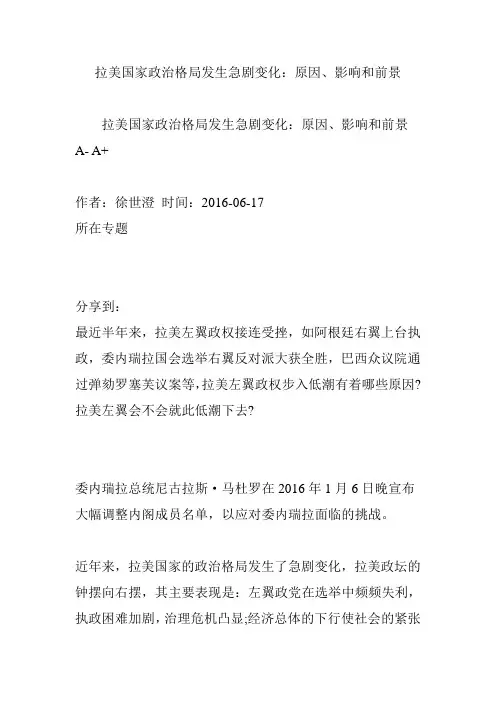
拉美国家政治格局发生急剧变化:原因、影响和前景拉美国家政治格局发生急剧变化:原因、影响和前景A- A+作者:徐世澄时间:2016-06-17所在专题分享到:最近半年来,拉美左翼政权接连受挫,如阿根廷右翼上台执政,委内瑞拉国会选举右翼反对派大获全胜,巴西众议院通过弹劾罗塞芙议案等,拉美左翼政权步入低潮有着哪些原因?拉美左翼会不会就此低潮下去?委内瑞拉总统尼古拉斯·马杜罗在2016年1月6日晚宣布大幅调整内阁成员名单,以应对委内瑞拉面临的挑战。
近年来,拉美国家的政治格局发生了急剧变化,拉美政坛的钟摆向右摆,其主要表现是:左翼政党在选举中频频失利,执政困难加剧,治理危机凸显;经济总体的下行使社会的紧张气氛加剧,社会对立情绪高涨,民众抗议持续不断。
拉美政坛的钟摆向右摆1999 年2 月2 日,查韦斯通过选举获胜就任委内瑞拉总统。
随后,拉美一系列国家的左翼政党在大选中获胜,使左翼或中左翼政党掌权的拉美国家达到十多个。
以此为标志,拉美左翼力量出现群体性崛起,影响力快速提升。
但是,最近半年来,拉美左翼政府接连受挫,拉美左翼式微的标志如下。
阿根廷右翼上台执政。
2015 年11 月22 日在阿根廷第二轮总统选举中,右翼“变革”联盟候选人、“共和国方案”党领袖马克里以3% 的微弱优势,战胜了在第一轮中得票领先的左翼执政联盟胜利阵线候选人肖利,当选为阿根廷新总统,12 月10日马克里正式就任,从而结束了正义党左翼领导人基什内尔和他的夫人费尔南德斯连续12 年的执政。
马克里就任总统后,采取了放开汇率、解雇大量公务员、大幅度提高家用电费、煤气费、公共交通价格,与美国“秃鹫基金”达成和解,同意以现金方式偿还总额约120 亿美元的债务等一系列新自由主义的措施,虽然改善了外国投资环境,但是影响了中下层民众的生活,抗议浪潮不断。
委内瑞拉在2015 年12 月6 日举行国会选举,右翼反对派联盟“民主团结平台”赢得三分之二以上的议席,在167 个议席中获112 席,执政党统一社会主义党仅取得55 席。
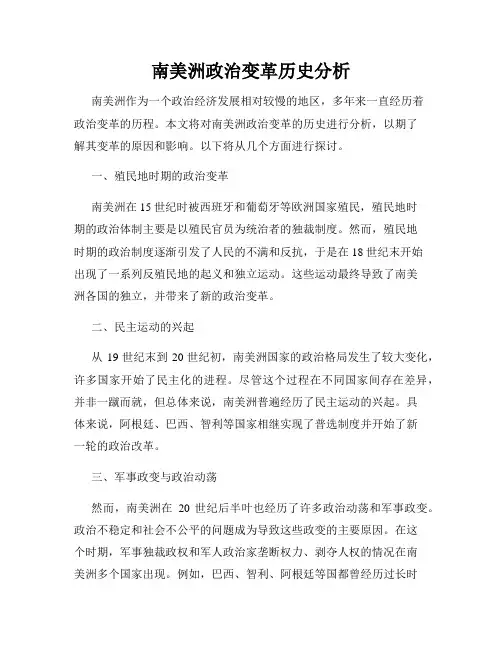
南美洲政治变革历史分析南美洲作为一个政治经济发展相对较慢的地区,多年来一直经历着政治变革的历程。
本文将对南美洲政治变革的历史进行分析,以期了解其变革的原因和影响。
以下将从几个方面进行探讨。
一、殖民地时期的政治变革南美洲在15世纪时被西班牙和葡萄牙等欧洲国家殖民,殖民地时期的政治体制主要是以殖民官员为统治者的独裁制度。
然而,殖民地时期的政治制度逐渐引发了人民的不满和反抗,于是在18世纪末开始出现了一系列反殖民地的起义和独立运动。
这些运动最终导致了南美洲各国的独立,并带来了新的政治变革。
二、民主运动的兴起从19世纪末到20世纪初,南美洲国家的政治格局发生了较大变化,许多国家开始了民主化的进程。
尽管这个过程在不同国家间存在差异,并非一蹴而就,但总体来说,南美洲普遍经历了民主运动的兴起。
具体来说,阿根廷、巴西、智利等国家相继实现了普选制度并开始了新一轮的政治改革。
三、军事政变与政治动荡然而,南美洲在20世纪后半叶也经历了许多政治动荡和军事政变。
政治不稳定和社会不公平的问题成为导致这些政变的主要原因。
在这个时期,军事独裁政权和军人政治家垄断权力、剥夺人权的情况在南美洲多个国家出现。
例如,巴西、智利、阿根廷等国都曾经历过长时间的军事独裁统治。
这些政权对民主化进程造成了严重的阻碍,同时也导致了南美洲社会和经济的不稳定。
四、现代化与民主的共存随着时间的推移,南美洲各国逐渐意识到军事独裁无法实现持久的政治稳定和经济发展。
为了实现现代化和民主的共存,多数国家在20世纪末和21世纪初进行了一系列的政治改革。
其中,巴西和智利在这个过程中发挥了重要的示范作用。
巴西通过实行民主制度、推进经济改革、加强社会福利,成功实现了政治和经济的稳定。
智利也通过持续的民主进程,成功实现了政权的和平过渡。
总结:南美洲政治变革的历史可以分为殖民地时期的反抗、民主运动的兴起、军事政变与政治动荡和现代化与民主的共存几个阶段。
每个阶段都对南美洲国家的政治、经济和社会发展产生了深远的影响。
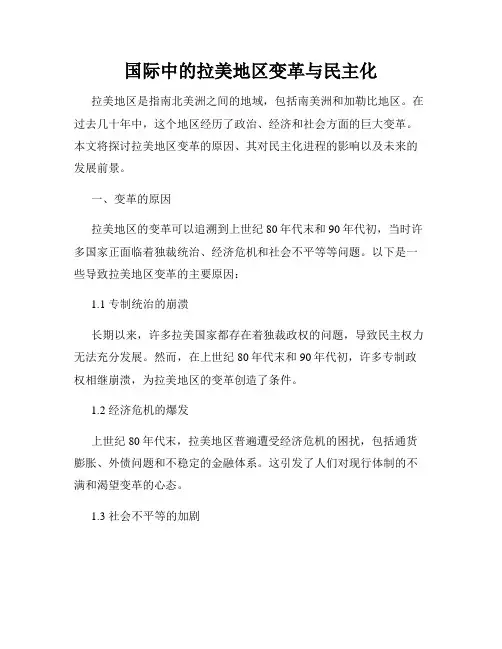
国际中的拉美地区变革与民主化拉美地区是指南北美洲之间的地域,包括南美洲和加勒比地区。
在过去几十年中,这个地区经历了政治、经济和社会方面的巨大变革。
本文将探讨拉美地区变革的原因、其对民主化进程的影响以及未来的发展前景。
一、变革的原因拉美地区的变革可以追溯到上世纪80年代末和90年代初,当时许多国家正面临着独裁统治、经济危机和社会不平等等问题。
以下是一些导致拉美地区变革的主要原因:1.1 专制统治的崩溃长期以来,许多拉美国家都存在着独裁政权的问题,导致民主权力无法充分发展。
然而,在上世纪80年代末和90年代初,许多专制政权相继崩溃,为拉美地区的变革创造了条件。
1.2 经济危机的爆发上世纪80年代末,拉美地区普遍遭受经济危机的困扰,包括通货膨胀、外债问题和不稳定的金融体系。
这引发了人们对现行体制的不满和渴望变革的心态。
1.3 社会不平等的加剧拉美地区一直以来存在着严重的社会不平等问题,富人和穷人之间的差距日益加大。
此情况激发了广大民众的不满,迫使政府采取措施来解决这一问题。
二、民主化的影响拉美地区的变革不仅仅是政治制度的转变,也包括对民主化的追求。
以下是拉美地区变革对民主化进程的主要影响:2.1 政治体制的转型拉美地区的变革推动了从专制统治向民主体制的转变。
许多国家进行了宪法改革和选举制度改革,以加强公民的参与和政府的责任。
2.2 社会运动的兴起变革期间,拉美地区涌现了大量的社会运动和抗议行动。
这些活动旨在争取更多的民主权利和社会正义,推动社会的变革和发展。
2.3 国际影响力的增加拉美地区的变革使其在国际舞台上的地位得到提高。
新的政治领导人通过积极参与国际事务,加强了拉美地区与其他国际角色的合作和对话。
三、未来的发展前景尽管拉美地区已经取得了一些进展,但仍然面临许多挑战。
以下是未来发展的一些关键问题和前景:3.1 经济发展的可持续性拉美地区的经济发展仍然不稳定,面临着如贫困、失业和不平等等问题。
未来的发展需要解决这些经济挑战,促进可持续发展和包容性增长。
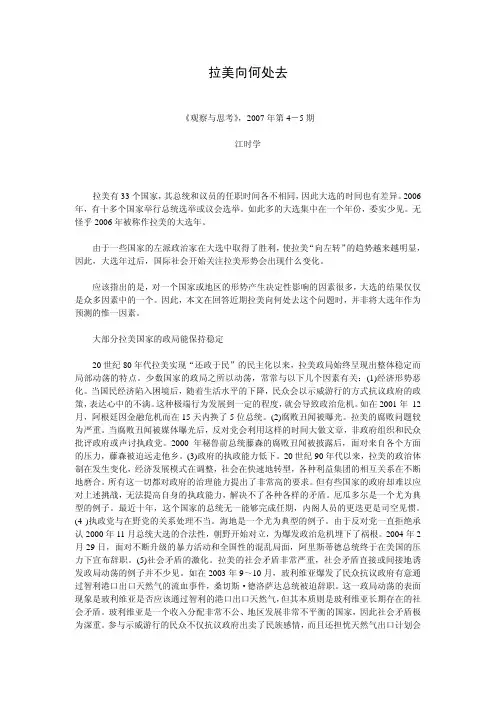
拉美向何处去《观察与思考》,2007年第4-5期江时学拉美有33个国家,其总统和议员的任职时间各不相同,因此大选的时间也有差异。
2006年,有十多个国家举行总统选举或议会选举。
如此多的大选集中在一个年份,委实少见。
无怪乎2006年被称作拉美的大选年。
由于一些国家的左派政治家在大选中取得了胜利,使拉美“向左转”的趋势越来越明显,因此,大选年过后,国际社会开始关注拉美形势会出现什么变化。
应该指出的是,对一个国家或地区的形势产生决定性影响的因素很多,大选的结果仅仅是众多因素中的一个。
因此,本文在回答近期拉美向何处去这个问题时,并非将大选年作为预测的惟一因素。
大部分拉美国家的政局能保持稳定20世纪80年代拉美实现“还政于民”的民主化以来,拉美政局始终呈现出整体稳定而局部动荡的特点。
少数国家的政局之所以动荡,常常与以下几个因素有关:(1)经济形势恶化。
当国民经济陷入困境后,随着生活水平的下降,民众会以示威游行的方式抗议政府的政策,表达心中的不满。
这种极端行为发展到一定的程度,就会导致政治危机。
如在2001年 12月,阿根廷因金融危机而在15天内换了5位总统。
(2)腐败丑闻被曝光。
拉美的腐败问题较为严重。
当腐败丑闻被媒体曝光后,反对党会利用这样的时间大做文章,非政府组织和民众批评政府或声讨执政党。
2000年秘鲁前总统藤森的腐败丑闻被披露后,面对来自各个方面的压力,藤森被迫远走他乡。
(3)政府的执政能力低下。
20世纪90年代以来,拉美的政治体制在发生变化,经济发展模式在调整,社会在快速地转型,各种利益集团的相互关系在不断地磨合。
所有这一切都对政府的治理能力提出了非常高的要求。
但有些国家的政府却难以应对上述挑战,无法提高自身的执政能力,解决不了各种各样的矛盾。
厄瓜多尔是一个尤为典型的例子。
最近十年,这个国家的总统无一能够完成任期,内阁人员的更迭更是司空见惯。
(4 )执政党与在野党的关系处理不当。
海地是一个尤为典型的例子。
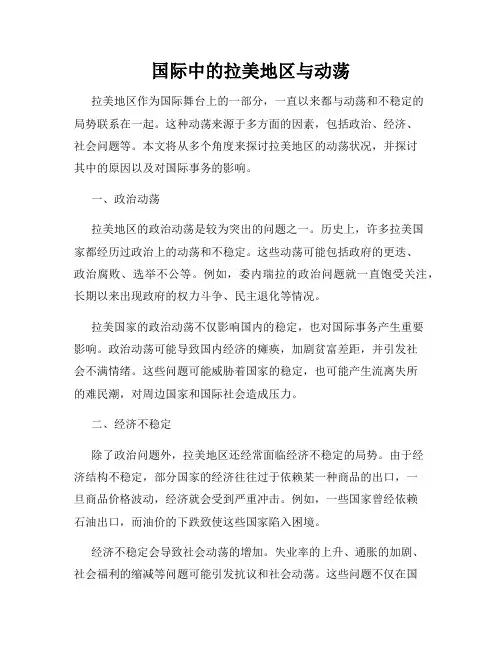
国际中的拉美地区与动荡拉美地区作为国际舞台上的一部分,一直以来都与动荡和不稳定的局势联系在一起。
这种动荡来源于多方面的因素,包括政治、经济、社会问题等。
本文将从多个角度来探讨拉美地区的动荡状况,并探讨其中的原因以及对国际事务的影响。
一、政治动荡拉美地区的政治动荡是较为突出的问题之一。
历史上,许多拉美国家都经历过政治上的动荡和不稳定。
这些动荡可能包括政府的更迭、政治腐败、选举不公等。
例如,委内瑞拉的政治问题就一直饱受关注,长期以来出现政府的权力斗争、民主退化等情况。
拉美国家的政治动荡不仅影响国内的稳定,也对国际事务产生重要影响。
政治动荡可能导致国内经济的瘫痪,加剧贫富差距,并引发社会不满情绪。
这些问题可能威胁着国家的稳定,也可能产生流离失所的难民潮,对周边国家和国际社会造成压力。
二、经济不稳定除了政治问题外,拉美地区还经常面临经济不稳定的局势。
由于经济结构不稳定,部分国家的经济往往过于依赖某一种商品的出口,一旦商品价格波动,经济就会受到严重冲击。
例如,一些国家曾经依赖石油出口,而油价的下跌致使这些国家陷入困境。
经济不稳定会导致社会动荡的增加。
失业率的上升、通胀的加剧、社会福利的缩减等问题可能引发抗议和社会动荡。
这些问题不仅在国内造成问题,也可能对国际经济产生影响。
例如,拉美地区的经济困境可能导致国际市场的不稳定,进而影响其他国家的经济发展。
三、社会问题的挑战拉美地区也面临着一系列的社会问题的挑战。
这些问题包括犯罪率上升、贫困问题、教育和卫生等基础设施的不足等。
这些社会问题给拉美社会带来了内忧外患,也对国际社会产生了一定的影响。
犯罪问题是拉美地区常见的社会问题之一。
枪械暴力、贩毒活动等犯罪行为频繁发生,使得社会治安形势严峻。
这不仅对国内居民造成生活上的困扰,还对国际游客和投资者的安全形势产生负面影响。
犯罪问题还可能与其他国家的安全合作产生影响,甚至成为国家间关系的紧张因素。
另外,贫困问题也是拉美地区亟待解决的社会问题之一。
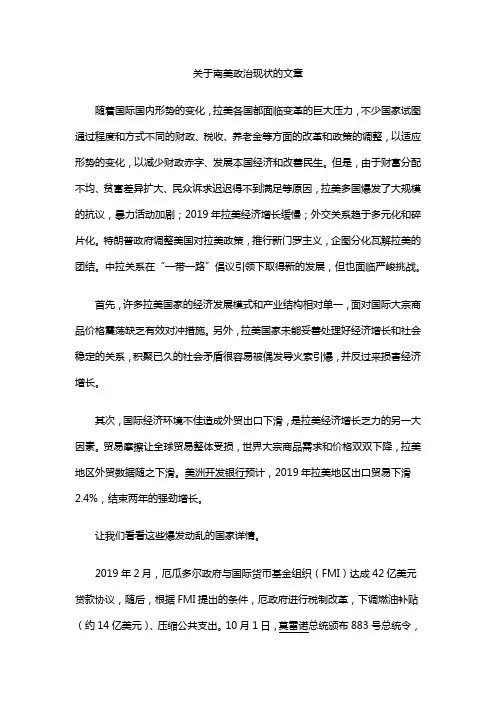
关于南美政治现状的文章随着国际国内形势的变化,拉美各国都面临变革的巨大压力,不少国家试图通过程度和方式不同的财政、税收、养老金等方面的改革和政策的调整,以适应形势的变化,以减少财政赤字、发展本国经济和改善民生。
但是,由于财富分配不均、贫富差异扩大、民众诉求迟迟得不到满足等原因,拉美多国爆发了大规模的抗议,暴力活动加剧;2019年拉美经济增长缓慢;外交关系趋于多元化和碎片化。
特朗普政府调整美国对拉美政策,推行新门罗主义,企图分化瓦解拉美的团结。
中拉关系在“一带一路”倡议引领下取得新的发展,但也面临严峻挑战。
首先,许多拉美国家的经济发展模式和产业结构相对单一,面对国际大宗商品价格震荡缺乏有效对冲措施。
另外,拉美国家未能妥善处理好经济增长和社会稳定的关系,积聚已久的社会矛盾很容易被偶发导火索引爆,并反过来损害经济增长。
其次,国际经济环境不佳造成外贸出口下滑,是拉美经济增长乏力的另一大因素。
贸易摩擦让全球贸易整体受损,世界大宗商品需求和价格双双下降,拉美地区外贸数据随之下滑。
美洲开发银行预计,2019年拉美地区出口贸易下滑2.4%,结束两年的强劲增长。
让我们看看这些爆发动乱的国家详情。
2019年2月,厄瓜多尔政府与国际货币基金组织(FMI)达成42亿美元贷款协议,随后,根据FMI提出的条件,厄政府进行税制改革,下调燃油补贴(约14亿美元)、压缩公共支出。
10月1日,莫雷诺总统颁布883号总统令,宣布取消对汽油等燃油的价格补贴,这一措施导致油价大涨并引发民众不满。
大批印第安土著居民从厄各地向首都基多进发,举行大规模示威抗议活动,引发厄10多年来最严重的社会动荡。
10月3日,厄交通运输业工会宣布举行全国大罢工,得到广泛响应。
抗议者在主干道燃烧轮胎,阻碍车辆正常通行,造成城市交通陷入瘫痪。
首都基多抗议者投掷汽油弹和石块,与警方发生冲突,抗议者强行进入总审计长办公室,还占领了议会大楼,摧毁了数十个玫瑰农场、一个奶牛场和石油生产设施。
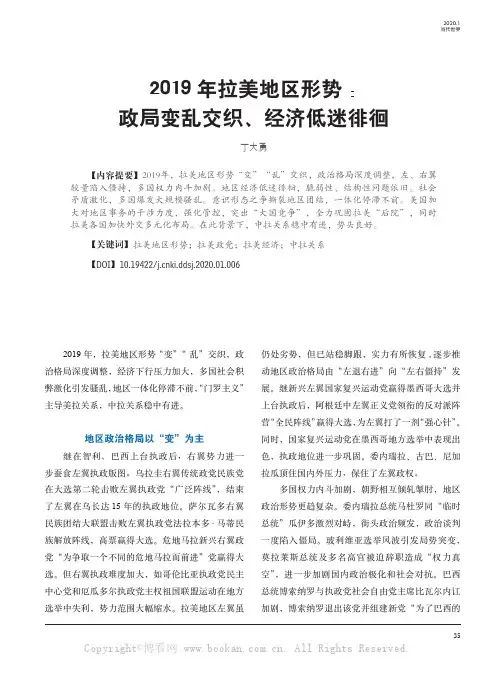
2019年,拉美地区形势“变”“乱”交织,政治格局深度调整,经济下行压力加大,多国社会积弊激化引发骚乱,地区一体化停滞不前,“门罗主义”主导美拉关系,中拉关系稳中有进。
地区政治格局以“变”为主继在智利、巴西上台执政后,右翼势力进一步蚕食左翼执政版图。
乌拉圭右翼传统政党民族党在大选第二轮击败左翼执政党“广泛阵线”,结束了左翼在乌长达15年的执政地位。
萨尔瓦多右翼民族团结大联盟击败左翼执政党法拉本多·马蒂民族解放阵线,高票赢得大选。
危地马拉新兴右翼政党“为争取一个不同的危地马拉而前进”党赢得大选。
但右翼执政难度加大,如哥伦比亚执政党民主中心党和厄瓜多尔执政党主权祖国联盟运动在地方选举中失利,势力范围大幅缩水。
拉美地区左翼虽仍处劣势,但已站稳脚跟,实力有所恢复,逐步推动地区政治格局由“左退右进”向“左右僵持”发展。
继新兴左翼国家复兴运动党赢得墨西哥大选并上台执政后,阿根廷中左翼正义党领衔的反对派阵营“全民阵线”赢得大选,为左翼打了一剂“强心针”。
同时,国家复兴运动党在墨西哥地方选举中表现出色,执政地位进一步巩固。
委内瑞拉、古巴、尼加拉瓜顶住国内外压力,保住了左翼政权。
多国权力内斗加剧,朝野相互倾轧掣肘,地区政治形势更趋复杂。
委内瑞拉总统马杜罗同“临时总统”瓜伊多激烈对峙,街头政治频发,政治谈判一度陷入僵局。
玻利维亚选举风波引发局势突变,莫拉莱斯总统及多名高官被迫辞职造成“权力真空”,进一步加剧国内政治极化和社会对抗。
巴西总统博索纳罗与执政党社会自由党主席比瓦尔内讧加剧,博索纳罗退出该党并组建新党“为了巴西的2019年拉美地区形势:政局变乱交织、经济低迷徘徊丁大勇【内容提要】2019年,拉美地区形势“变”“乱”交织,政治格局深度调整,左、右翼较量陷入僵持,多国权力内斗加剧。
地区经济低迷徘徊,脆弱性、结构性问题依旧。
社会矛盾激化,多国爆发大规模骚乱。
意识形态之争撕裂地区团结,一体化停滞不前。
美国加大对地区事务的干涉力度,强化管控,突出“大国竞争”,全力巩固拉美“后院”,同时拉美各国加快外交多元化布局。
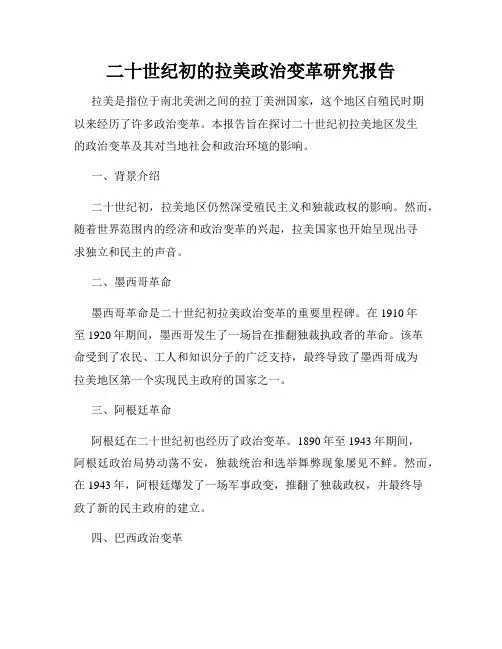
二十世纪初的拉美政治变革研究报告拉美是指位于南北美洲之间的拉丁美洲国家,这个地区自殖民时期以来经历了许多政治变革。
本报告旨在探讨二十世纪初拉美地区发生的政治变革及其对当地社会和政治环境的影响。
一、背景介绍二十世纪初,拉美地区仍然深受殖民主义和独裁政权的影响。
然而,随着世界范围内的经济和政治变革的兴起,拉美国家也开始呈现出寻求独立和民主的声音。
二、墨西哥革命墨西哥革命是二十世纪初拉美政治变革的重要里程碑。
在1910年至1920年期间,墨西哥发生了一场旨在推翻独裁执政者的革命。
该革命受到了农民、工人和知识分子的广泛支持,最终导致了墨西哥成为拉美地区第一个实现民主政府的国家之一。
三、阿根廷革命阿根廷在二十世纪初也经历了政治变革。
1890年至1943年期间,阿根廷政治局势动荡不安,独裁统治和选举舞弊现象屡见不鲜。
然而,在1943年,阿根廷爆发了一场军事政变,推翻了独裁政权,并最终导致了新的民主政府的建立。
四、巴西政治变革巴西也是二十世纪初发生政治变革的国家之一。
在1930年至1945年的时期,巴西发生了一系列政变和军事独裁统治。
然而,这些政治动荡最终导致了1945年的一次革命,重新确立了民主政府。
五、智利的政治变革智利在二十世纪初也经历了政治变革。
从1970年到1973年,智利实施了一系列社会主义政策,这引起了国内外的争议。
1973年,一场由军方领导的政变颠覆了合法政府,暴力冲突导致了长时间的军事统治。
六、政治变革的影响这些二十世纪初的拉美政治变革对当地社会和政治环境产生了深远影响。
首先,它们为拉美地区带来了更多的民主和自由。
同时,政治变革也制约了贫富差距的扩大,并推动了社会正义和平等的追求。
七、总结二十世纪初的拉美政治变革给这个地区带来了长期的政治和社会影响。
墨西哥、阿根廷、巴西和智利的例子展示了当时拉美国家追求民主和自由的努力。
这些政治变革为拉美国家树立了现代化的政治制度,并为后来的变革奠定了基础。
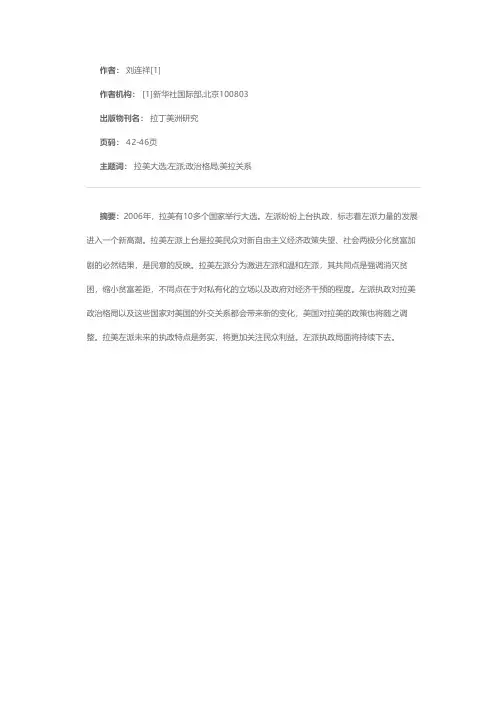
作者: 刘连祥[1]
作者机构: [1]新华社国际部,北京100803
出版物刊名: 拉丁美洲研究
页码: 42-46页
主题词: 拉美大选;左派;政治格局;美拉关系
摘要:2006年,拉美有10多个国家举行大选。
左派纷纷上台执政,标志着左派力量的发展进入一个新高潮。
拉美左派上台是拉美民众对新自由主义经济政策失望、社会两极分化贫富加剧的必然结果,是民意的反映。
拉美左派分为激进左派和温和左派,其共同点是强调消灭贫困,缩小贫富差距,不同点在于对私有化的立场以及政府对经济干预的程度。
左派执政对拉美政治格局以及这些国家对美国的外交关系都会带来新的变化,美国对拉美的政策也将随之调整。
拉美左派未来的执政特点是务实,将更加关注民众利益。
左派执政局面将持续下去。

拉美新“粉红浪潮”的成因、特点及前景作者:周志伟来源:《当代世界》2022年第08期进入21世纪以来,左翼一直在拉美政治生态中占据主导地位。
1998年底,查韦斯当选委内瑞拉总统,拉美左翼由此开启“粉红浪潮”周期并持续到2016年前后。
此后,拉美地区出现了“左退右进”的态势,但仅维持了3年左右时间。
2018年,墨西哥左翼政党国家复兴运动在大选中获胜,次年阿根廷左翼联盟“全民阵线”候选人费尔南德斯当选总统,拉美政治生态呈现明显的“向左回摆”态势。
2020—2022年,左翼政党相继在玻利维亚、秘鲁、尼加拉瓜、洪都拉斯、智利、哥伦比亚等国大选中获胜,拉美地区重新回归到左翼执政占多数的局面,这也被外界解读为新“粉红浪潮”。
自20世纪70年代民主化浪潮以来,拉美政治生态的大调整通常与地区系统性危机密切关联。
21世纪初拉美“粉红浪潮”体现的是对新自由主义弊端的反思与批判,彼时拉美左翼政府或从意识形态层面或从政策层面,针对新自由主义发展模式的替代方案进行了不同程度的探索。
相较而言,本轮新“粉红浪潮”的出现更多折射出地区国家政府治理低效问题,尤其是在应对新冠肺炎疫情上的集体失效。
具体而言,拉美新“粉红浪潮”的形成缘由可从以下层面进行考察。
第一,治理低效、新冠肺炎疫情催生右翼主政的“短命”周期。
21世紀的第二个十年被认为是拉美经历的又一个“失去的十年”,尤其是在2014—2019年间地区年均GDP增长率仅为0.4%,甚至不及上一个“失去的十年”(20世纪80年代债务危机)时期的均值(0.5%)。
拉美在过去10年很明显出现了严峻的治理困局。
这种局面导致“粉红浪潮”逐渐退潮:2015年,阿根廷结束了12年的左翼执政周期,委内瑞拉反对党联盟赢得议会选举的多数;2016年,巴西劳工党也结束了将近14年的执政周期。
此后3年间,在主要拉美国家中,左翼执政的仅剩古巴、委内瑞拉和尼加拉瓜等少数国家。
然而,治理问题对主政的右翼政府同样是考验,而右翼政府的表现同样不如人意。
从南美洲三国大选看拉美政治生态变化南美洲是世界上最为多样化和多元化的地区之一,拥有丰富的文化和历史背景。
近年来,南美洲各国的政治生态发生了许多变化,其中选举成为了这些变化的一个重要标志。
本文将以巴西、阿根廷和委内瑞拉三个南美洲国家的大选为例,分析拉美政治生态的变化。
巴西巴西是南美洲最大的国家,也是世界上面积第五大的国家。
自从1891年成为共和国以来,巴西的政治体制经历了多次变革,包括军事独裁和民主化等。
近年来,巴西政治生态发生了许多变化,其中最为显著的就是2018年总统选举的结果。
2018年,巴西举行了总统选举,最终由右翼候选人雅伊尔·博索纳罗获得胜利,成为了巴西新一任总统。
博索纳罗是一位备受争议的政治人物,他的观点和言论经常引发争议。
博索纳罗的当选意味着巴西政治生态的变化。
他的当选象征着巴西对传统政治精英的不满和对新观念的追求。
他的政见和言论虽然备受争议,但在选举中却取得了巨大的支持。
这表明巴西民众对政治变革的渴望和对传统政治精英的不信任。
阿根廷阿根廷是南美洲第二大国家,也是西班牙语系的国家之一。
阿根廷的政治生态也经历了多次变化,2019年总统选举就是其中的一个标志性事件。
2019年,阿根廷举行了总统选举,最终由阿尔贝托·费尔南德斯当选为新一任总统。
费尔南德斯是一位左翼政治人物,曾在2007年至2015年担任过阿根廷总统。
他的再次当选意味着阿根廷政治生态的变化。
费尔南德斯的再次当选反映了阿根廷民众对政治的期待和对传统政治精英的不满。
他在选举中承诺要改革经济政策,缓解通货膨胀问题,改善民生条件,这些都得到了选民的支持。
他的再次当选也意味着阿根廷政治将向左转,对传统的新自由主义政策可能会产生影响。
委内瑞拉委内瑞拉是南美洲的一个特殊国家,近年来由于政治和经济问题备受关注。
2018年,委内瑞拉举行了总统选举,最终由尼古拉斯·马杜罗再次当选为新一任总统。
马杜罗是一位左翼政治人物,曾在2013年成为委内瑞拉总统。
拉美地区的政治转型与民主进程拉美地区的政治转型与民主进程摘要:拉美地区是一个多元的地方,其政治历史一直以来都相当复杂。
在过去的几十年里,这一地区经历了一系列的政治转型和民主进程,其中一部分地区成功地实现了民主制度的建立,而另一部分地区则仍面临着许多挑战。
本文将从拉美地区的历史背景、政治转型的原因、民主进程的特点以及面临的挑战等方面进行探讨,以便更好地了解拉美地区政治转型和民主进程的现状及其影响。
1. 拉美地区的历史背景拉美地区是指南美洲和中美洲的地区,由20多个国家组成。
在欧洲殖民时期,拉美地区大部分地区属于西班牙和葡萄牙的殖民地。
这些国家在独立后便建立了相应的政治体系,但这些国家的政治局势一直不稳定,且常常受到外部势力的影响。
此外,拉美地区还经历过激进的左翼政治运动和军事独裁统治。
2.政治转型的原因拉美地区的政治转型有许多原因。
首先,国内的经济问题是政治转型的一个主要原因。
多数拉美国家面临着经济不稳定、贫困、失业等问题,这导致了社会不满情绪的积累,进而促使政治变迁。
其次,拉美地区长期以来存在的社会不平等和权力集中也是政治转型的因素之一。
许多拉美国家存在着少数精英阶层占据大量资源和权力的问题,这导致了社会的不平等性加剧,从而激发了广大人民的抗议和变革要求。
再次,全球化的影响也是拉美地区政治转型的原因之一。
全球化的进程使国际间的经济和政治联系更加紧密,拉美地区的政治和经济问题成为国际社会关注的焦点,这加大了国内政治变革的压力,鼓励了拉美国家进行政治转型。
3.民主进程的特点在拉美地区的民主进程中,有一些共同的特点。
首先,拉美地区的民主进程往往是在政治危机和社会抗议的推动下实现的。
许多拉美国家在经历了政治动荡和经济困境之后,采取了向民主的转变。
其次,拉美地区的民主进程常常带有一定的左翼色彩。
在过去的几十年里,拉美地区出现了许多左翼政党的兴起,这些政党在执政后往往采取了一系列的民主改革措施,以促进社会福利和减少社会不平等。
当代世界2017年11月至2019年11月,拉美政坛经历了一个“超级选举周期”。
两年间,拉美14个国家举行了总统选举。
[1]2018年更是一个每隔12年才会出现的“超级选举年”,该地区两大经济体巴西和墨西哥举行了大选,哥伦比亚、委内瑞拉、哥斯达黎加、巴拉圭也举行了大选或总统选举。
回顾这个“超级选举周期”的选举结果,可以发现:拉美国家的传统政党不断衰败,新兴政党异军突起,政党格局出现了重大变化。
拉美政党政治变化的新特点拉美政党政治在最近的“超级选举周期”中表现出以下三个基本特点。
第一,新兴政党竞相崛起,传统政党呈现明显的衰败势头。
在2018年哥伦比亚大选之中,成立于2013年的民主中心党实现首次执政;两大传统政党保守党和自由党加速衰落,前者未能推出自己的总统候选人,而后者的总统候选人则无力进入第二轮选举。
在2018年墨西哥大选中,成立仅 4 年的左翼政党国家复兴运动党一举成为执政党,该党候选人洛佩斯 · 奥夫拉多尔赢得压倒性胜利,这是该国自2000年大选以来又一次重大政党轮替。
作为墨西哥传统大党的革命制度党遭受重挫,其候选人在总统选举中仅位居第三,在9场州长选举中全部告负,国会众、参两院的席位均大幅下降。
在哥斯达黎加,新兴的中左派政党公民行动党打破两大传统政党民族解放党和基督教社会团结党自二战之后长期执政的政治格局,于2014年首次上台执政,并在2018年大选中再度获胜;而上述两大传统政党候选人首次同时未能进入总统选举第二轮。
在2017年洪都拉斯总统选举中,来自新兴政党反腐败党的萨尔瓦多·纳斯拉亚,在总统选举中仅以微弱劣势告负。
在2019年萨尔瓦多大选中,来自民族团结大联盟的纳伊布·布克尔当选总统,一举打破马蒂阵线和民族主义共和联盟近30年轮流执政的格局。
“超级选举周期”与拉美政党政治新变化王 鹏【内容提要】 2017年11月至2019年11月,拉美政坛经历了一个“超级选举周期”。
拉美政党政治新变化与左翼政党的政策调整作者:徐世澄来源:《当代世界》2020年第11期【内容提要】近年来,拉美政党政治发生了一些新变化,左翼力量呈现复苏态势,在拉美经济第二大国墨西哥首次掌权、第三大国阿根廷重新执政;温和左翼成立“普埃布拉集团”,以整合地区左翼力量;左翼政党、共产党等力量多次召开会议,反对美国干涉。
拉美多数国家的政党格局处于变动之中,一些传统政党趋于衰败,一些新兴政党异军突起;一些国家政党体系的弱化呈加剧之势。
面对新挑战,拉美左翼执政党不断调整政策,以提高治理能力,而左翼在野党则通过议会斗争和地方选举不断扩大影响力。
在美国的持续制裁和打压下,拉美左翼整体发展并不理想,加上意识形态分歧,左翼政党之间和政党内部矛盾突出,难以形成有效合力对抗美国干涉和本地区右翼势力挤压。
【关键词】拉美政党;拉美左翼;拉美共产党;政党格局【DOI】10.19422/ki.ddsj.2020.11.010近年来,拉美地区左翼力量发展态势向好,在多个地区国家取得执政地位,由其主导的地区一体化机制逐渐焕发出活力,地区共产党也日趋活跃,部分拉美国家的政党格局出现新变化。
尽管如此,拉美地区左翼的整体发展仍不尽人意,彼此之间因为意识形态差异矛盾重重,难以形成合力对抗美国干涉和本地区右翼势力挤压。
2020年最后一个季度至2021年初,拉美地区多国将面临选举和公民表决,左翼力量能否维持基本盘并持续扩大影响,值得关注。
拉美地区左翼力量呈现复苏态势一是拉美左翼政党在多国执政参政,地区“左退右进”的趋势发生较大变化。
2018年7月,由墨西哥国家复兴运动党、劳动党和社会汇合党组成的左翼“我们共同创造历史”联盟在墨西哥大选中胜出,国家复兴运动党总统候选人洛佩斯·奥夫拉多尔当选总统,同年12月1日正式就任,这是左翼政党首次在地区第二大经济体墨西哥执政。
就任后,洛佩斯总统对内大刀阔斧地实施“第四次变革”,赢得了大多数民众的支持。
自2015年阿根廷左翼在大选中落败,委内瑞拉右翼在议会中获得控制权,2016年巴西总统迪尔玛•罗塞芙被弹劾下台,继任的米歇尔•特梅尔总统组织了以中右翼为主的政府,拉美政治的“左退右进”已成定局。
2016年以来,南方共同市场(以下简称“南共市”)和美洲国家组织成为拉美政治斗争的重要战场,其中受影响最大的就是激进左翼国家委内瑞拉。
南共市和美洲国家组织对委内瑞拉的政策变化说明拉美地区主流意识形态和政策的重大变化。
当前,委内瑞拉作为世界石油储量最大的国家,激进左翼仍然控制着国家权力,不可避免地成为区内外右翼势力夺取的首要目标。
凭借左翼共识,委内瑞拉成功加入南共市自2004年12月委内瑞拉成为南共市的联系国,到2012年7月底被批准成为南共市正式成员国,先后耗时七年半之久。
这在当时左翼群体性崛起的拉美实在难以想见,右翼根据当前拉美政治格局的“左退右进”——从南共市和美洲国家组织对委内瑞拉的政策变化谈起为什么2012年查韦斯的改革被右翼批评为“民主的倒退”时,委内瑞拉仍然能够突破其阻挠成功加入南共市?为什么2016年的马杜罗政府被右翼指责人权记录、“宪法秩序”遭到破坏时委内瑞拉却被南共市中止了成员国资格,而且又面临美洲国家组织中止其成员国资格的威胁?其根本原因绝不仅仅是委内瑞拉的民主状况,而是当前拉美政治格局的“左退右进”使然。
■ 杨建民/文DOI: 10.19422/ki.ddsj.2017.05.013南共市中的“民主条款”进行阻挠是其中的根本原因。
20世纪80年代以来,“民主条款”是一些拉美一体化组织的必备条款。
无论是美国曾长期主导的美洲国家组织,还是拉美国家组成的南共市、南美洲国家联盟,无不将“民主条款”写入一体化文件。
1987年,在阿根廷和巴西商讨建立拉普拉塔商业合作区时,曾就“只有民主国家才能加入该一体化计划”达成共识。
玻利维亚虽然距拉普拉塔河口甚远,但因其是“民主国家”,可以加入该计划,而当时仍然处在独裁统治之下的巴拉圭则被排除在外。
南美洲的历史变革与政治格局南美洲被誉为世界上最为多样化的地区之一,其多元的文化、历史和政治格局,构成了这个地区独特的面貌。
然而,在南美洲的历史长河中,政治变革一直是一个重要的节点。
本文将探讨南美洲的历史变革以及政治格局的演变。
一、南美洲的历史变革南美洲的历史可以追溯到公元前9000年,当时这片土地上生活着原始的部落社会。
随着时间的推移,南美洲的历史经历了许多政治和文化的变革。
1. 南美洲的原住民在南美大陆,原住民文化是最为重要和特殊的文化之一。
在过去几千年的时间里,南美洲原住民的社会生活主要以狩猎、采集和种植为主。
其中一些原住民在战争和剥削下消失,但是还有一些原住民基本保持了其文化。
这些部落比如:阿马佐纳斯,卡纳利斯,迪亚曼蒂那都受到了南美洲的历史变革的影响。
2. 殖民地化在16世纪,西班牙人和葡萄牙人开始进入南美洲,并将其变为殖民地,对南美的社会、政治、文化产生了深远的影响。
西班牙帝国和葡萄牙帝国在南美洲的殖民管辖下,活跃一百年的贸易关系,给南美洲带来了巨大的变化和破坏。
在广阔的土地和丰富的资源面前,殖民者只知道剥削。
但是殖民时期变革也刺激了南美洲本地经济的发展,例如社会制度改革,经济发展、新的信仰、法律制度和语言。
殖民统治时期结束后,殖民国家特别是西班牙从南美洲撤离,南美洲的独立运动也逐渐形成。
3. 独立运动南美历史变革的一个深远影响是对殖民地的反抗和独立战争。
在1810年开头,南美洲国家逐渐展开取得独立的运动。
如阿根廷、智利、巴拉圭、秘鲁、哥伦比亚等独立都面临大种族、文化、宗教甚至道德上的分裂和矛盾。
独立战争的胜利,让南美洲的国家得以摆脱了殖民化的历史,重新成为独立的主权国家。
4. 近代化随着时间的推移,南美洲国家经历了独立运动后的近代化进程。
19世纪在南美洲开始向自由和宪政转化,南美的近代化运动主要表现在政治、法律和经济方面。
许多南美洲国家也成为了全球的经济强国。
然而,随之而来的问题是在社会和贫富差距方面南美洲的问题。
从南美洲三国大选看拉美政治生态变化
拉丁美洲自从独立以来,经历了一系列政治变革,无论是革命还是民主选举,都留下了深刻的印记。
随着时代的变化,拉美地区的政治生态也在不断地演变和发展,其中大选是最为常见和直观的政治形态之一。
2021年11月在南美洲三个国家分别举行了大选,分别是智利、阿根廷和尼加拉瓜。
这三个国家的选举结果不仅反映了本国的政治形势,也展现了拉美地区的一些政治现象和生态变化。
智利大选:市场化改革遭到质疑
智利是拉美地区最为稳定和发达的国家之一,但近年来其内部经济、社会秩序和政治形势却一直动荡不安。
2021年11月21日,智利举行了总统、国会和地方选举。
最终由左翼候选人、绿色组织成员加布里埃尔·博罗斯当选总统,结束了右翼政治集团长达30多年的执政时代。
在智利的大选中,候选人们更多地关注到了智利社会上的不平等和市场化改革所带来的问题,民众也表达了对市场经济和新自由主义的质疑。
此外,多数候选人还强调了环保、能源、教育和医疗改革等议题,反映了社会民主主义价值观在政治生态中的发展。
阿根廷大选:社会议题和国际关系成为关键议题
阿根廷是南美洲第二大经济体,近年来面临着通货膨胀、经济衰退和政治动荡等问题。
2021年11月14日,阿根廷总统和众议院议员选举举行,由前总统克里斯蒂娜·费尔南德斯·德基什内尔再次当选总统。
在阿根廷的大选中,候选人们更多地关注到了社会议题和国际关系,例如穆斯林武装组织塔利班最近掌权所带来的国际影响、巴西总统博索纳罗在阿根廷的批评、国内的社会保障和财政紧缩问题等。
此外,大选候选人还关注到了全球环保和气候变化这些全球性议题,体现出阿根廷政治生态的开放性和超越国界的意识形态。
尼加拉瓜大选:大选处于封锁状态
尼加拉瓜是中美洲最贫穷的国家之一,由于该国的政治紧张局势,2021年11月7日举行的总统和议会选举遭到了封锁和抵制。
该国已经被国际社会拒之门外,选举结果也一直没有正式宣布。
在尼加拉瓜的大选中,政治生态变化表现得最为明显。
当前的政治形势极为紧张,大选被指控为有组织的违法行径,而该国的政治领导层也被批评为专制、侵犯人权、压制言论自由、制造社会动荡等。
尼加拉瓜的大选结果还是未知数,但当前的政治生态已经暴露出了许多深层次问题。
综上所述,南美洲三国不同的大选结果反映了该地区的不同种类的政治生态和变革,其中包括正义、社会主义、自由主义、保守主义、全球化、国家主义等不同的政治理念和发展方向。
在未来的政治进程中,这些元素都将继续影响拉美地区的政治生态和全球政治经济格局。